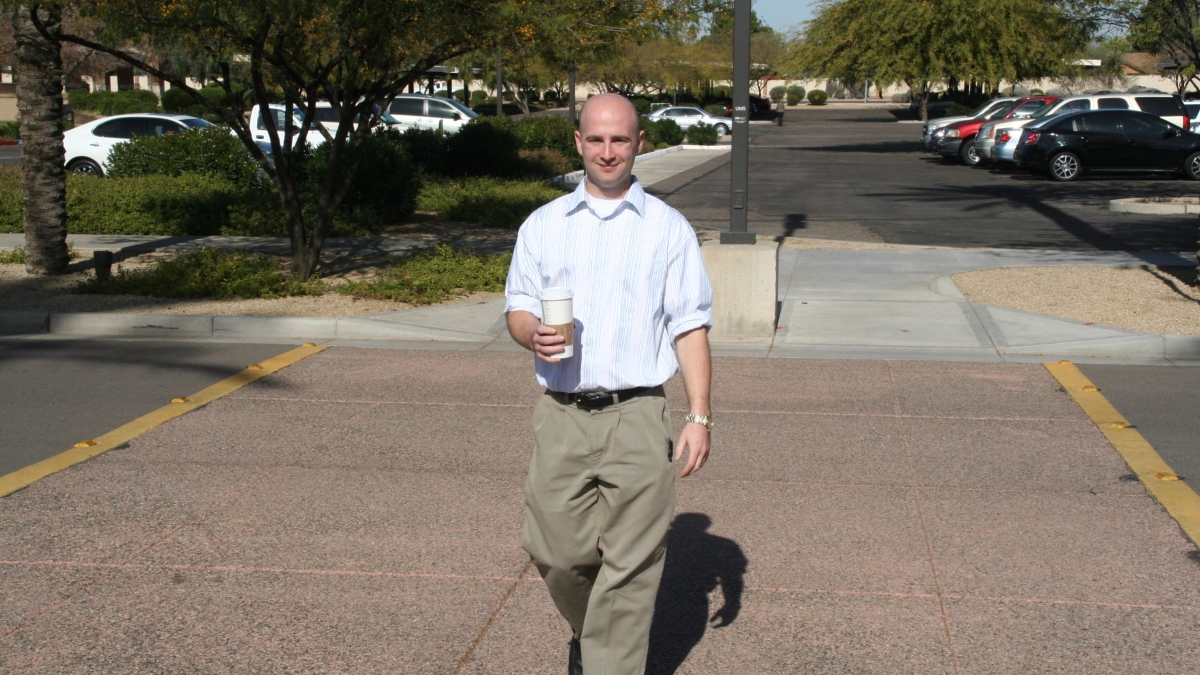Music listeners attentive while crossing street, research shows

We may not know why the iPod user crossed the road, but research indicates he paid as much attention in doing so as the typical non-iPod user.
ASU faculty member Evan Risko and colleagues observed people crossing at two busy crosswalks in a real-world setting. They investigated how much attention was paid by users versus non-users of iPods and other personal music devices (PMDs). The researchers noted head movements associated with assessing the traffic situation and whether pedestrians slowed or stopped before entering the crosswalk.
For females, there was no significant difference in cautionary behavior between users and non-users of PMDs. For males, PMD users actually displayed a greater amount of cautionary behavior than non-users. The results are discussed in “The effects of personal music devices on pedestrian behavior,” published in the January 2012 issue of the journal Safety Science.
Does this mean that it’s perfectly safe to walk through a busy city with your favorite musician “cranked up” on your PMD? Not so fast, says Risko, an assistant professor in ASU’s New College of Interdisciplinary Arts and Sciences, based on the West campus.
“This study demonstrated that PMDs influence behavior differently from cell phones,” Risko said. “Multiple studies have shown that talking on a cell phone causes an attentional problem; pedestrians who are engaged in cell phone conversations are ‘absorbed’ in their conversations and simply become dangerously unaware of their environment.
“While we didn’t find evidence for an attentional deficit in individuals wearing PMDs, using a PMD blocks out sounds from the environment, and these sounds – car horns, people’s voices, approaching vehicles – can be life-saving,” he said.
Risko’s advice for people walking on busy streets is not to use either a cell phone or a PMD. But if you’re going to use a PMD, he suggests lowering the volume or using only one ear bud or headphone. Cell phone usage is so distracting that Risko offers a stronger warning.
“You can’t ‘turn down’ a conversation,” he said. “If you must take a call while navigating city streets, it is best to ‘pull over’ – in other words, stop walking – have your conversation, and then continue.”
There are many more topics that can still be explored with regard to pedestrians and PMDs, Risko and his co-authors concluded. One example is to investigate what volume level users set their devices to, compared to environmental noise, and whether there are gender differences in this area as well.
The study by Risko and colleagues was published just as recently released statistics from the National Highway Traffic Safety Administration showed a 4.2 percent jump in pedestrian fatalities in 2010 from the previous year. This increase comes as road fatalities in most categories are falling.
The research for “The effects of personal music devices on pedestrian behavior” was conducted at two busy crosswalks on the Vancouver campus of the University of British Columbia, where Risko was a post-doctoral fellow before coming to ASU. The journal article’s first author is Esther Walker, who was an undergraduate student in Vancouver at the time and now is a graduate student at the University of California, San Diego.
At ASU, Risko has continued to give undergraduate students the opportunity to become involved in research projects. He runs the Cognition and Natural Behavior (CaNB) Laboratory on the West campus, and several undergrads participate in projects through that lab.
Risko said he strives to study human attention in as naturalistic a context as possible. “Traditional research in attention is typically far removed from the situations in which it operates during our day-to-day lives, such as crossing a street,” he said.
“Our research in CaNB focuses on two general topics – attention and the embodied and embedded aspects of cognition,” Risko said. “Questions currently driving our research include how people use their bodies and the world while they think, how our personality and our social environment relate to how we attend to the world, and how we can use attention to improve educational outcomes.”
“Evan Risko has been a wonderful addition to the psychology faculty of the Social and Behavioral Sciences division in New College,” said Carol Mueller, the division’s director. “His research on pedestrians and PMDs is just one of many outstanding projects he has used to attract students to practical applications of cognitive psychology.”
Risko, who came to ASU in 2010, teaches New College courses, including "Memory and Cognition" and "Sensation and Perception," as well as a graduate course on advanced issues in cognition for students in New College’s master’s degree program in psychology.
Prior to his post-doctoral fellowship at the University of British Columbia, Risko earned his doctorate at the University of Waterloo, also in Canada. Along with attention and cognition, his research interests include visual word recognition, individual differences, and learning and education.